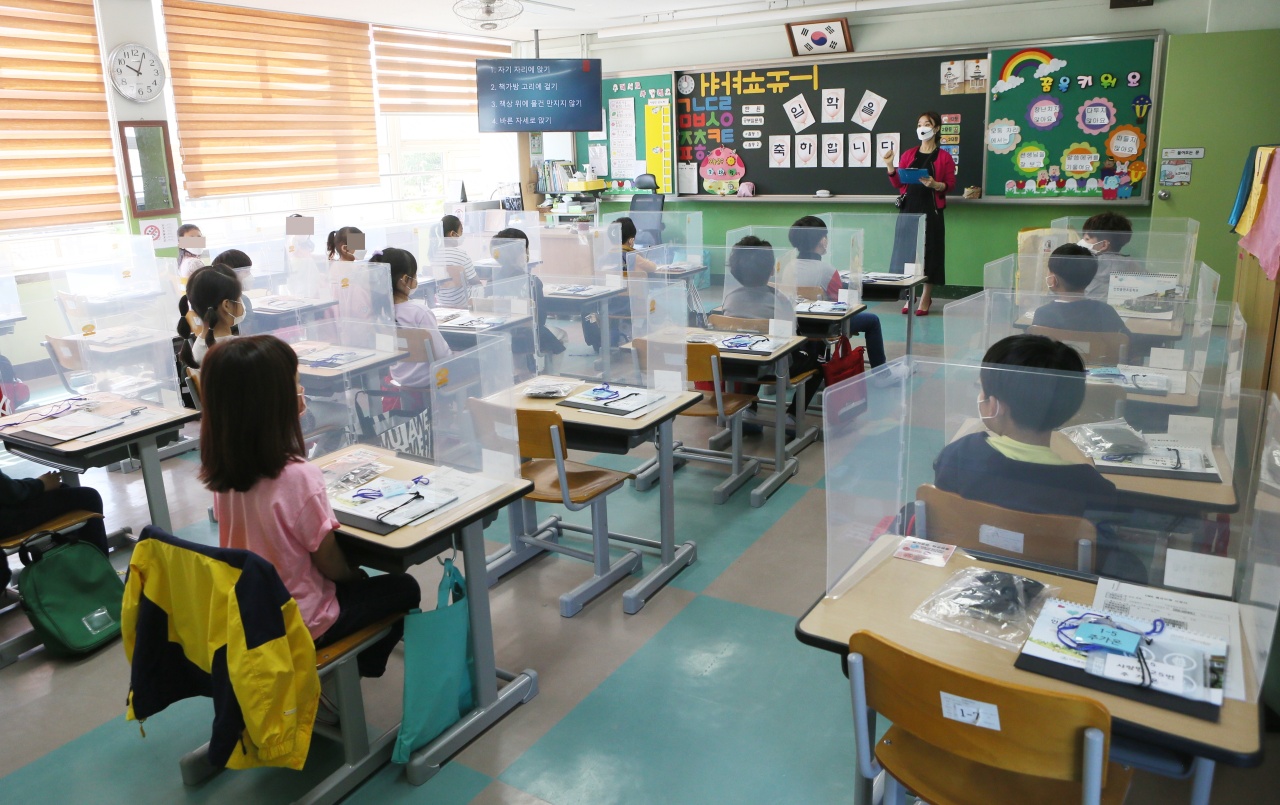More students return to school amid new surge in coronavirus cases
By YonhapPublished : May 27, 2020 - 15:09

More than 2 million more South Korean students returned to school Wednesday as the country saw a resurgence of confirmed novel coronavirus cases.
The Korea Centers for Disease Control and Prevention (KCDC) confirmed a total of 40 new cases, highest in 49 days, in the morning. Among them, 36 cases were reported in densely-populated Seoul and its surrounding areas.
The rise in the number of cases is largely attributed to local transmissions from a club cluster infection that started in the nightlife district of Itaewon in Seoul in early May.
Amid growing concerns over the spread of COVID-19, some 560 schools and kindergartens across the country postponed their reopenings.
In the face of the virus's ongoing spread, the reopening of schools is considered crucial to test the government's "everyday life quarantine" scheme. The scheme, introduced May 6, is designed to help people learn to live with the virus and resume normal life amid relaxed social distancing.
The students affected by the second phase of reopening are the two lowest grades of elementary school, kindergarten students, middle school seniors and second-year high school students. The estimated number of students is 2.37 million.
Last week, 440,000 high school seniors returned to school, more than two months behind schedule due to the COVID-19 pandemic. The country's academic year begins in March.
With Wednesday's reopenings, a total of 2.81 million, or 47 percent, of all students, including those in kindergartens, started attending in-person classes.
The resumption comes as health authorities are on alert over local transmissions in connection with the Itaewon cluster, including new outbreaks at a logistics center in Bucheon, west of Seoul.
The latest figure showed 259 cases were related to the Itaewon cluster and at least 36 cases are traced to e-commerce operator Coupang's logistics center.
While the first phase is considered to have gone off without a major problem, there is pervasive fear about potential COVID-19 outbreaks among young students.
There has been a spate of coronavirus infections involving students of various ages.
Earlier this week, a 6-year-old kindergarten boy was infected with the virus from his teacher. In the southern city of Daegu, a high school senior at Osung High School tested positive late Tuesday night, leading to the closure of six schools. In another case, a teacher at an elementary school tested positive.
Despite the government's confidence in managing the pandemic, parents and teachers are still worried that young children could struggle to keep quarantine and social distancing rules.
"I am worried about young children. High shool students can control themselves but for little ones, I am not convinced," Lee Yoon-hee, a working mother with two children, said.
Her oldest daughter, who is in her first year at a Seoul high school, went to school in the morning.
"I also worry about flexible school schedules. It makes life harder for parents like myself, because I have to adjust to any change that might arise," she said, referring to a potential sudden school closure or one-day-on, one-day-off schedules.
During a briefing Wednesday, Education Minister Yoo Eun-hae stressed the importance of "preemptive actions" in responding to the pandemic.
To curb new infections, a total of 561 kindergartens, elementary, middle and high schools across the country, or 2.7 percent of the total, had rescheduled their reopening to later dates. With this, the number of students who returned to school Wednesday was lower than originally expected.
By region, 111 schools in Seoul and 181 in Gumi, North Gyeongsang Province, postponed their reopening. The figure was the highest in Bucheon at 251, with a new infection cluster at the Coupang distribution center there.
She also pointed out the imperatives of resuming in-person classes.
"Remote classes is not enough to fully educate students, which is only possible through face-to-face classes," she said.
To calm parents' anxiety, the ministry increased the number of permissible absent days so that students can stay at home without worrying about school attendance.
Also, schools have more leeway over setting up schedules to minimize classroom crowding, such as alternating school days for different classes. High school seniors go to school every day to prepare for the national university entrance exam slated for early December.
By grade, high school classrooms run at two-thirds of their full attendance, while the figure is one-third for middle and elementary schools.
Schools in areas with more infections are strongly advised not to fill classrooms with more than two-thirds of students.
The ministry also offers staffing and logistics assistance to schools to help run after-school day care programs smoothly for working parents.
To monitor and tackle potential outbreaks at schools, the ministry is in close coordination with the KCDC and provincial education offices.
The government also unveiled a set of relaxed guidelines on mask use at schools amid warmer weather.
Students are permitted not to wear masks on a playground and during outdoor classes on condition that they can stay at least 1 meter apart from each other.
If efficient ventilation and distancing are guaranteed, they also don't need to wear masks when attending small classes or doing extracurricular activities.
Also they can take off masks when feeling dizzy and having shortness of breath.
Ahead of summer, which is expected to be hotter than last year, according to the national weather agency, the government ordered schools to turn on air-conditioners with windows closed and to ventilate classrooms at every recess.
Previously the government had advised leaving windows ajar when using air-conditioners, to limit the spread of the virus through airborne droplets. (Yonhap)








![[Kim Seong-kon] Democracy and the future of South Korea](http://res.heraldm.com/phpwas/restmb_idxmake.php?idx=644&simg=/content/image/2024/04/16/20240416050802_0.jpg&u=)








![[KH Explains] Hyundai's full hybrid edge to pay off amid slow transition to pure EVs](http://res.heraldm.com/phpwas/restmb_idxmake.php?idx=652&simg=/content/image/2024/04/18/20240418050645_0.jpg&u=20240418181020)

![[Today’s K-pop] Zico drops snippet of collaboration with Jennie](http://res.heraldm.com/phpwas/restmb_idxmake.php?idx=642&simg=/content/image/2024/04/18/20240418050702_0.jpg&u=)